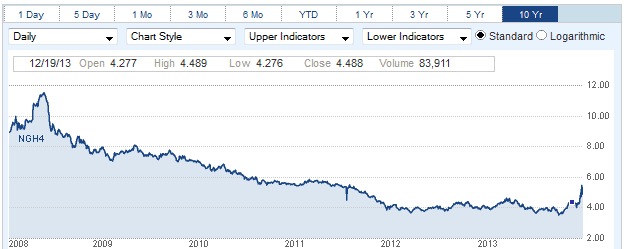TheGreenSupplyChain.com believes that 2014 will be a critical year for the move towards natural gas powered trucks, and may be later seen as an inflection point, with a critical mass of companies announcing plans to move in that direction, following a series of such announcements in late 2013. (See Lowes to Expand Natural Gas Truck Program with Complete Conversion at Texas Distribution Center.)
But is there a chance sharply rising natural gas prices could derail this transition?
The US has among the lowest natural gas prices in the world, with the price per thousand cubic feet hovering between in the $3.50 to $4.50 range since the start of 2012 through late 2013.
Compare that to more like $12.00 per MCF in Europe, and as high at $15-17.00 in Asia. That significant price differential has made the US much more competitive in energy-intensive industries such as chemicals and metals production, and the low price makes made operating trucks much less expensive with natural gas versus diesel.
As recently as June of 2008, US natural gas prices were at about $11.50 per MCF, after which they began a long and steady slide (see chart below), reaching as low as $3.57 just this past November. The driver of that plunge, of course, has been the explosion in US natural gas production from fracking techniques. In fact, so much natural gas in being produced that the price continued to fall even as US gas consumption rose sharply as utilities and factories switched to nat gas from coal or electricity.
Natural Gas Prices have Spiked in Recent Weeks, After Some 5 Years of Declines

But right after that recent low, prices shot by about $1.00, back to around $4.50, a rise of some 29%. After a brief pullback in early January, natural gas has spiked up again, rising another $1.00 per MCF to around $5.50, and as of today is just under that price point. Those are the highest price levels for natural gas in more than seven years.
The increase is being blamed in part on the brutally cold winter, as consumers and businesses use more gas to heat homes and buildings. As usual with energy markets, speculators betting on a continued rise in natural gas prices are also said to be a contributing factor.
So with prices up 30% or more from where companies such as Lowes and UPS were making big commitments to nat gas trucks, are the economics of the move now distorted?
In a word, No, says Jim Harger of Clean Energy Fuels, a company founded by legendary energy investor T. Boone Pickens that is building a network of public and private natural gas filling stations across the US.
That is in part because the actual cost of natural gas represents only about 20% of the cost at the pump for shippers or carriers. That is substantially below the 60% or so that oil costs represents for final diesel fuel prices.
So, every dollar rise in the price of core natural gas only increases the price at the pump by only about 14 cents per "diesel gallon equivalent" (DGE), Harger says.
He told SCDigest that "Natural gas recently increased from $3.75 per MCF to $5.00 per MCF. That $1.25 increase in cost per MCF, a rise of about 33%, translated to a just a 17-cent increase in cost per diesel gallon equivalent."
Harger adds that Clean Energy current sell natural gas at its filling stations for about $2.60 per DGE, while diesel fuel is about $3.95 per gallon on average across the country. So, that $1.35 delta in natural gas' favor, times an average of 20,000 gallons used for a class 8 truck per year, results in fuel savings of about $27,000 annual. That savings then has to be compared to the additional cost of a nat gas truck (about $30,000 or so more than a diesel truck today, but a delta that is sure to shrink some in coming years, SCDigest believes).
Natural Gas Price Rise will Spur More Production
Meanwhile, the rise in natural gas prices is likely to spur additional production that will increase supplies that could push prices back down. In a 2012 interview with SCDigest editor Dan Gilmore, Pickens said that "When you get to $5.00 [per MCF], you'll find the industry gets back to more drilling again, and that will keep the price down."
The bottom line: natural gas price would have to rise dramatically even from these higher levels to substantially alter the high level economics of natural gas trucks, a development that seems highly unlikely for many years.
Do you think the rise in nat gas prices will impact that adoption of natural gas trucks? How high would it have to go to be a real barrier? Let us know your thoughts at the Feedback button below.

|